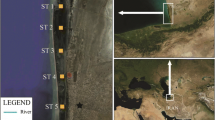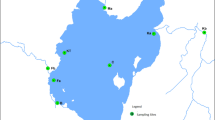Abstract
The growing increase in population and urbanization expansion leads to corresponding increase in urban effluents, industrial and agriculture that discharged into the aquatic environment. The present paper is an attempt to estimate the water quality characteristics and zooplankton community of different water bodies in some human activities effects of Mariout Lake subjected to various types of pollutants by using statistical simulation. During the period beginning from March 2019 to February 2020, ten representative surface water samples were collected seasonally from Mariout Lake for determination of physico-chemical parameters, namely temperature, biological oxygen demand, salinity, hydrogen ion concentration, ammonia, dissolved oxygen, reactive phosphate, and chlorophyll were estimated. The results of the monitoring stations were analyzed by multivariate statistical techniques to measure relationship among physical and chemical parameters by principal component analysis (PCA) and canonical correlation analysis (CCA) techniques. A total of 78 species were from zooplankton population, additional to fish eggs and the larval stages of different groups. Rotifer formed 48 species, copepods formed 8 species additional nauplii larvae and copepodite stage, protozoans (6 species: one of each of Protozoan, Ciliatea, tintinnids, and Sessilida), Cladocera 5 species, Ostracoda 4 species, Insecta 2 larvea, Mollusca 1 species and one larvae, while Annelida, Nematoda, Cirripeda, Molluscs, Annelida, Amphipoda, and fish eggs were only represented by one organism each. The annual average values of physico-chemical parameters were 24.26 °C for temperature; 4.07 ± 1.28‰ for salinity; 8.015 ± 0.22 for pH; 9.07 ± 9.56 mg/L for DO; 19.49 ± 5.22 mg/L for BOD; 0.54 ± 0.27 mg/L foe ammonia; 0.426 μM for reactive phosphate; and 6.312 μg/L for chlorophyll-a. From the calculations of WQI, the lakes were categorized into good, bad, and poor water quality. Increasing pollution rate of Mariout Lake will create large areas of oxygen-depleted (hypoxic) dead zones, which affect fish, zooplankton, and other organisms in the lake. Verifying the ability of CCA and PCA techniques was achieved by correlation methods and simple regression respectively.




















Similar content being viewed by others
Change history
15 April 2021
Springer Nature’s version of this paper was updated to present the correct city of the first affiliation.
References
Abbai SS, Sunkad BN (2013) Effect of anthropogenic activities on zooplankton population of sogal international science congress association short communication. Res J Recent Sci 2(7):81–83
Abdar MR (2013) Physico-chemical characteristics and phytoplankton of Morna Lake, Shirala (M.S.) India. Biolife. An International Quarterly. J Bio Life Sci 1(2):1–7
Abdel-aziz NE, Aboul-ezz SH (2004) The structure of zooplankton community in Lake Maryout, Alexandria, Egypt. Egypt J Aquat Res 30:160–170
Abou El-Gheit EN, Abdo MH, Mahmoud SA (2012) Impact of blooming phenomenon on water quality and fishes in qarun Lake, Egypt. Intern J Environ Sci Eng (IJESE) 3:11–23
Ahmed ME (2015) Evaluation of the physicochemical and chlorophylla conditions of a subtropical aquaculture in Lake Nasser area, Egypt. Beni-Suef Univ Basic Appl Sci 4(4):327–337. https://doi.org/10.1016/j.bjbas.2015.11.009
Aminul Islam M, Morton D, Bruce BJ, Angove MB (2020) Adsorption of humic and fulvic acids onto a range of adsorbents in aqueous systems, and their effect on the adsorption of other species: a review. Spear Purif Techno 247:116949. https://doi.org/10.1016/j.seppur.2020.116949
Aminul Islam M, Awual R, Angove M (2019) A review on nickel (II) adsorption in single and binary component systems and future path. J Environ Chem Eng 7:103305. https://doi.org/10.1016/j.jece.2019.103305
Aminul Islam M, Morton D, Johnson BB, Angove M (2018) Manganese oxides and their application to metal ion and contaminant removal from wastewater. J Wat Proc Eng 26:264–280. https://doi.org/10.1016/j.jwpe.2018.10.018
AlProl AE (2019) Recent textile effluents treatment technology: a review. Asia J Fish Aqua Res 3(2):1–18
American Public Health Association (APHA)/ AWWA (n.d.) Standard methods for the examination of water, and waste water, 22nd edition, 1360 - ISBN 978-087553-013-0.
American Public Health Association. (2012) WPCF Washington DC, USA.
APHA (American Public Health Associations) (1995) Standard methods for the examination of water and wastewater.19th edition.
Beveridge MCM (2004) Cage aquaculture, 3rd edn. Blackwell Science, Oxford, pp 164–182
Bishai HM, Youssef FS (1977) Some aspects on the hydrography, physico chemical characteristics and fisheries of Lake Manzala. Bull Inst Ocean Fish ARE 7:32–58
Carlson RE (1977) A trophic state index for lakes. Limnol Oceanogr 22(2):361–369
Edmondson WT (1959) Freshwater biology, 2nd edn. Wiley, New York, p 1248
EEAA, Egyptian Fourth Low Environment (1994) Egyptian environment agency. Egypt. Egyp J Aqu Bio Fish 12:119–132
Egyptian Environmental Affairs Agency (EEAA) (2009). Alexandria integrated coastal zone management project - environmental and social impact assessment (AICZMP- ESIA).
El Zokm GM, Tadros HR, Okbah M, Ibrahim G (2018) Eutrophication assessment using TRIX and Carlson’s indices in Lake Mariout Water, Egypt. Egyp J Aqu Bio Fish 22(5):321–339
El-Alfy MA, Hasballah AF, Abd El-Hamid HT, El-Zeiny AM (2019) Toxicity assessment of heavy metals and organochlorine pesticides in freshwater and marine environments, Rosetta area. Egypt using multiple approaches J Sust Envir Res:19–29
El-Damhogy KA, Nasef AM, Heneash AMM, Khater ME (2016) Diversity and distribution of Brachionus community (Rotifera: Brachionidae) at lake Maryout, Alexandria, Egypt. J F A S 4(5):500–506
El-Enany HR (2009) Ecological studies on planktonic and epiphytic micro-invertebrates in Lake Nasser, Egypt. Ph.D. Zool. Dept. Thesis, Fac. Sci. Benha Univ, 311.
El-Feky MM, Alprol AE, Heneash AMM, Abo-Taleb H, Omer M (2018) Evaluation of water quality and plankton for Mahmoudia canal in northern west of Egypt. Egyp J Aqu Bio Fish 22(5):461–474
El-Sharkawi FM (1999) Pollution control of Lake Mariout, International conference on environmental management, health and sustainable development, held in Alexandria, Egypt, 22-25.
Garg RK, Rao RJ, Saksena DN (2009) Water quality and conservation management of Ramsagar reservoir, Datia, Madhya Pradesh. J Environ Biol 30(5):909–916
Ghoneim MM, El-Desoky HS, El-Moselhy KM, Amer A, Abou El-Naga EH, Mohamedein L, AlProl AE (2014) Removal of cadmium from aqueous solution using marine green algae Ulva lactuca. Egypt J Aquat Res 40:235–242
Heneash AMM (2015) Assessment of water quality of unfertilized fish farm using zooplankton diversity index and some abiotic factors. Egy J Aqua Fish 19(3):35–44
Haque MI (2008) Water resources management in Bangladesh. Anushilan, Chuadanga & Dhaka, pp 24–84
Helal A, Abdelaty B, Elokaby M, Mustafa M, Hosny S, Heneash AMM (2020) Ecosystem management of al-nozha airport farm lake, Egypt utilizing TSI model. Inter J Fish Aqua Study 8:137–145
Heneash A, Alprol A (2020) Monitoring of water quality and zooplankton community in presence of different dietary levels of commercial wood charcoal of red tilapia. J Aqua Res Develop 11:1–11
Illinois Pollution Control Board (IPCB) (1990) Rules and regulations, Title 35: Environmental Protection, Subtitle C: Water Pollution, Chapter I. IEPA, 195 p. Springfield, IL.
Intergovernmental Oceanographic Commission (IOC) (1983) Nutrient analysis in tropical marine waters, manuals and guides. UNESCO 28:1–24
Jeffrey SW, Humphrey GF (1975) New spectrophotometric equations for determining chlorophylls a, b, c1 and c2 in higher plants, algae and natural phytoplankton. Biochem Physiol Pflanz 167(2):191–194
Khan MR, Milind J, Ustad IR (2012) Physicochemical analysis of Triveni lake water of Amravati district in (MS) India, Bioscience Discovery, 3(1): 64–66. Heranj Lake, Dist. Kheda- Gujarat. Asi J Exper Bio Sci 3(3):582–588
Khater MEM (2017) Environmental impact assessment for human activities and some physico-chemical factors on zooplankton at Maryout Lake, Alexandria, Egypt. Msc. Zool. Dept. Thesis, Fac. Sci. Al-Azhar. Univ.
Kulkarni SV, Tapase BS (2011) Physico- Chemical parameters and water quality index of Gandhisagar Lake of Umrer in Nagpur district
Kumar P, Jetani KL, Yusuzai SI, Sayani AN, Dar SA, Rather MA (2012) Effect of sediment and water quality parameters on the productivity of coastal shrimp farm. Pelag Res Lib Adva app Sci Res 3(4):2033–2041
Lazur A (2007) JIFSAN good aquacultural practices manual, growout pond and water quality management, Section 6. Univ of Maryland:1–18
Lokhande RS, Singare PU, Pimple DS (2011) Study on physico-chemical parameters of wastewater effluents from taloja industrial area of mumbai, India. Intern J Ecos 1(1):1–9
Mahvi AH, Nouri J, Babaei AA, Nabizadeh R (2005) Agricultural activities impact on groundwater nitrate pollution. Intern J Environ Sci Techno 2(1):41–47
Masoud MS, Mohamed EA, Elewa AA, Alaa E (2005) Distibution sediments of lake edku, Egypt. Bull J Chem Techno of Maced 24(1):21–34
Metawea EAA (2009) Monitoring and Evaluation of some chemical parameters associated with changing the effluent rates on el-Rahawy drain and their impact on water quality of Rosetta branch. M.Sc. Thesis. Fac Sci Cairo University. Egypt.
Meybeck M, Chapman DV, Helmer R (1989) Global freshwater quality: A first assessment. WHO, UNEP, Paris, Basil Blackwell Ltd, Oxford, 306 p.
Mustafa EK, Liu G, El-Hamid HT, Kaloop MR (2019) Simulation of land use dynamics and its impact on land surface temperature in Beijing using satellite data. Geo J:1–19
Ogbuagu DH, Ayoade AA, Okoli CG (2012) Seasonal variations in physicochemical regime, bacterioplankton and mycoplankton of Imo River in Etche, Nigeria. J Micro & Biotechn Res 2(2):289–297 Available online at www.scholarsresearchlibrary.com
Pathak H, Pathak D (2012) Eutrophication: impact of excess nutrient status in lake water ecosystem. J Environ Anal Toxicol 2:148. https://doi.org/10.4172/2161-0525.1000148
Patra AP, Patra JK, Mahapatra NK, Das S, Swain GC (2010) Seasonal variation in physicochemical parameters of Chilika Lake after opening of new mouth near Gabakunda, Orissa, India. W J F M S 2(2):109–117 www.researchgate.net/publication/265105998
Ramadan AA (2003) Heavy metal pollution and biomonitoring plants in Lake Manzala, Egypt. Pak J Biol Sci 6(13):1108–1117. https://doi.org/10.3923/pjbs.2003.1108.1117
Saad SA, Magdy AM, Ranya AA, Mohamed AG (2017) Assessment of the physico-chemical characteristics and water quality analysis of Mariout Lake, Southern of Alexandria, Egypt. J Env Analy Toxic 7(1):421–440. https://doi.org/10.4172/2161-0525.1000421
Saler S (2009) Rotifers of Kepektas dam lake (Elazig- Turkey). Iran J Sci Techno Transaction A 33:121–126
Santhanam R, Srinivasan A (1994) A manual of marine zooplankton. Raju Primlani for oxford & IBH publishing Co. Pvt. Ltd. 5-7.
Simpson EH (1949) Measurement of diversity. Nature:163–688
Singh KP, Malik A, Mohan D, Sinha S (2004) Multivariate statistical techniques for the evaluation of spatial and temporal variations in water quality of Gomti River (India): a case study. Water Res 38(18):3980–3992. https://doi.org/10.1016/j.watres.2004.06.011
Strickland JDH, Parsons IR (1972) A practical handbook of sea water analysis. Fish Res Bd Canada Bull 167, 2nd Edition, 310.
Tiwari TN, Manzoor A (1988) Water quality index for Indian rivers. In: ecology and pollution of Indian River. Ashish Publishing House, New Delhi, pp, 271- 286.
USEPA (2000) Retrospective assessment of the costs of the clean water act: 1972 to 1997. Washington DC: US Environ. Protection Agency Contract number 67-W7-0018.
Valderrama JC (1981) The simultaneous analysis of total nitrogen and total phosphorus in natural waters. Mar Chem 10:109–122. https://doi.org/10.1016/0304-4203(81)90027-X
Wetzel R (2001) Limnology: lakes and rivers ecosystems. Academic Press, San Diego, pp 226–237
WHO (2004) Guidelines for drinking-water quality, health criteria and other supporting information, vol 2, 3rd edn. World Health Organization, Geneva
Yu S, Shang J, Zhao J, Guo H (2003) Factor analysis and dynamics of water quality of the Songhua River, Northeast China. Water Air Soil Pollut 144(1–4):159–169. https://doi.org/10.1023/A:1022960300693
Zakaria HY, El-Kafrawy SB, El-Naggar HA (2019) Remote sensing technique for assessment of zooplankton community in lake Mariout, Egypt. Egypt J Aqu Bio Fish 23(3):599–609
Author information
Authors and Affiliations
Corresponding author
Ethics declarations
I declare that the Submitted Research Paper is my original work and no part of it has been published any where else in the past.
Conflict of interest
The author(s) declare that they have no competing interests.
Additional information
Responsible Editor: Broder J. Merkel
Rights and permissions
About this article
Cite this article
Heneash, A.M., Alprol, A.E., Abd El-Hamid, H.T. et al. Assessment of water pollution induced by anthropogenic activities on zooplankton community in Mariout Lake using statistical simulation. Arab J Geosci 14, 641 (2021). https://doi.org/10.1007/s12517-021-06977-9
Received:
Accepted:
Published:
DOI: https://doi.org/10.1007/s12517-021-06977-9




